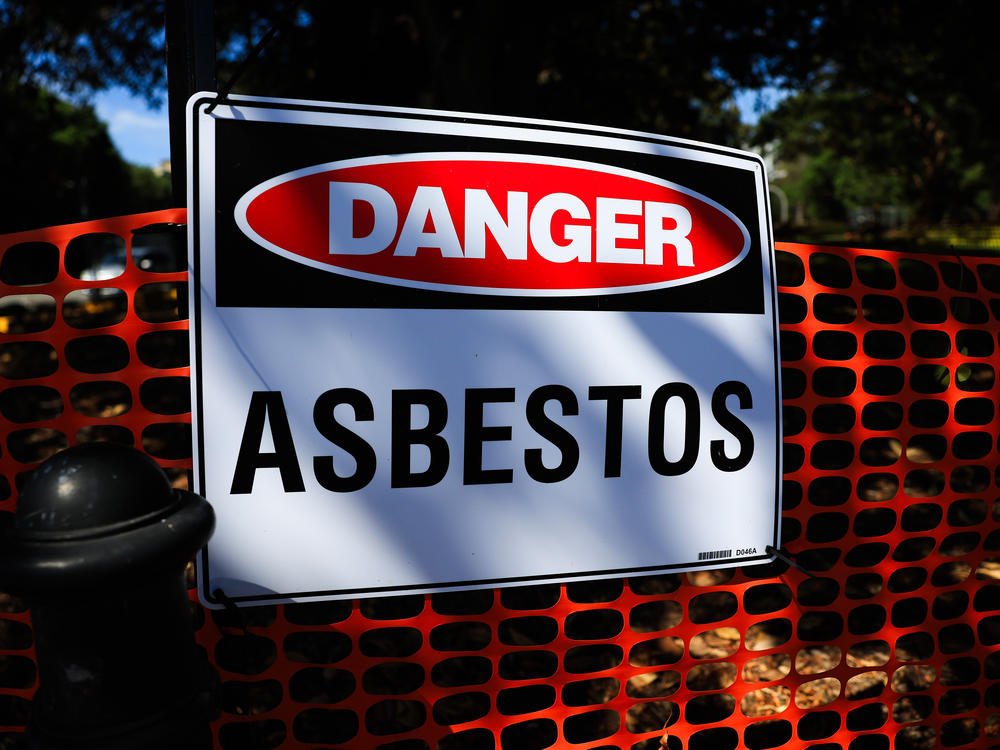Section Branding
Header Content
The U.S. bans most common form of asbestos, after decades of pushback from industry
Primary Content
The Environmental Protection Agency announced Monday that it is banning the most common form of asbestos, a cancer-causing substance that's linked to the deaths of tens of thousands of Americans every year.
The U.S. is prohibiting the use of chrysotile asbestos, joining more than 50 other countries that have already outlawed the substance. The ban comes after decades of pushback from companies that have used it in everything from consumer goods to manufacturing processes.
"The science is clear – asbestos is a known carcinogen that has severe impacts on public health," EPA administrator Michael Regan said in a statement. "This action is just the beginning as we work to protect all American families, workers, and communities from toxic chemicals."
People who inhale the tiny fibrous strands that make up asbestos can develop a slew of illnesses, including lung and ovarian cancer, asbestosis and mesothelioma. More than 40,000 deaths in the U.S. each year are connected to asbestos exposure.
Most consumer products that once contained the substance in the past no longer do, such as building materials and household appliances.
But the EPA's ban targets certain products that still carry asbestos, including some gaskets and aftermarket automotive products. It also phases out the use of asbestos diaphragms by the chlor-alkali industry, which produces various chemicals.
Arthur Frank, a professor of environmental and occupational health at Drexel University, said the rule doesn't outlaw all forms of asbestos, and the substance still lurks in many existing buildings and products across the country.
"This is not a total ban by any means," Frank said. "It is a modest step that reduces future exposures."
Why it's taken so long for the EPA to outlaw asbestos
Federal regulators said Monday that the ban was the first rule to be finalized under the updated Toxic Substances Control Act, the national chemical safety law that was overhauled in 2016.
Previous attempts to prohibit the use of asbestos fell flat.
The EPA tried to ban asbestos outright in the late 1980s, but companies fought back. When the agency announced its 1989 prohibition on the use of asbestos, there was a carve-out for the chlorine industry.
Then, two years later, a panel of federal judges deemed the rule too onerous and overturned it, scuttling for decades any additional attempts by the EPA to ban asbestos and other dangerous chemicals.
"An immediate ban on the import of chrysotile asbestos for the chlor-alkali industry is a long overdue step forward for public health," Sen. Jeff Merkley, D-Ore., said in a statement. "However, it cannot be the end of the road when it comes to phasing out other dangerous asbestos fibers, and Congress has a role to play here when it comes to providing stronger protections for our health."
What this ban will do
Though the use of asbestos in the U.S. has been on the wane, it hasn't vanished altogether.
The chlor-alkali industry uses large filters containing asbestos called diaphragms to make chemicals such as sodium hydroxide and chlorine, which can be used to disinfect drinking water and wastewater.
The EPA is immediately banning the import of chrysotile asbestos for the industry and requiring the eight chlor-alkali plants in the U.S. still using asbestos diaphragms to phase out their use.
Asbestos isn't required to produce chlorine, the agency noted, and two-thirds of the chlorine made in the U.S. is done so without the use of asbestos.
Producers will have five years to transition from using asbestos diaphragms to ones that don't contain the substance. Those that shift from asbestos diaphragms to non-asbestos membrane technology will have five years to convert their first facility, eight years to convert their second and 12 years to convert their third.
The ban also prohibits the use of asbestos in certain products. Oilfield brake blocks, aftermarket automotive brakes and linings, and other vehicle friction products and gaskets will be barred from containing asbestos six months after the rule's effective date.
Sheet gaskets containing asbestos will also be outlawed two years after the effective date of the rule, though there will be exceptions when it's used to make titanium dioxide or for the disposal of nuclear material.
Bottom Content




